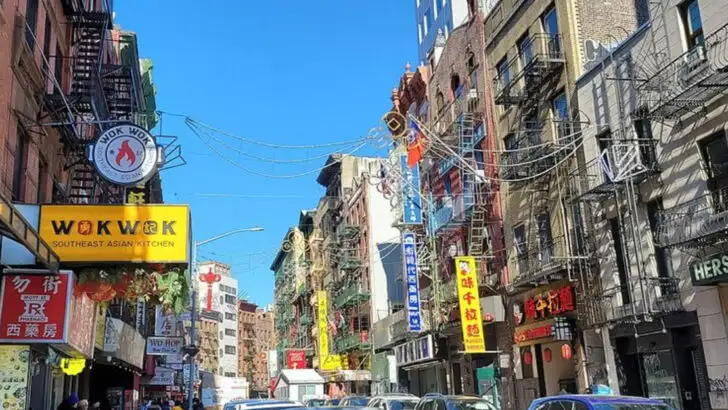New York’s Chinatown began as a small, struggling enclave shaped by hardship, discrimination, and the determination of early Chinese immigrants. Despite barriers, the community built a resilient foundation, creating businesses, associations, and traditions that offered stability in an unfamiliar city.
Over time, Chinatown transformed into a vibrant cultural landmark, celebrated for its heritage, cuisine, and historic streets that pulse with life. Today, visitors return not only for the flavors and sights, but for the story of perseverance woven through every block.
Early Chinese immigration waves
In the late 19th century, waves of Chinese immigrants ventured across the Pacific to the United States. Drawn by the promise of opportunity, many found themselves in New York City. Facing language barriers and cultural disconnect, they sought solace among fellow countrymen.
These early immigrants were primarily laborers, working tirelessly to survive. Over time, they began to lay down roots, forming the nucleus of what would become Chinatown. Their tenacity laid the groundwork for a community that would flourish against the odds.
Did you know? Despite harsh conditions, these pioneers persevered, setting a strong foundation for future generations.
Exclusion-era community networks
The Chinese Exclusion Act of 1882 marked a challenging period for New York’s Chinese community. Despite these hurdles, strong community networks began to emerge. These networks were crucial for providing mutual support and resources.
Community centers became lifelines, offering everything from employment advice to legal assistance. These relationships fostered a sense of unity and resilience, helping to mitigate the effects of exclusionary policies.
By banding together, these networks not only ensured survival but also laid the framework for a thriving community, showcasing the power of solidarity in adversity.
Family associations and tongs
In the shadow of adversity, family associations and tongs emerged as vital pillars of support. These organizations provided social services, including housing and job placements, to their members.
Family associations were often organized around a shared surname or regional origin. Meanwhile, tongs operated as secret societies that offered protection and community governance.
While they sometimes engaged in illicit activities, these groups played a significant role in maintaining social order and cultural traditions, ensuring that Chinatown remained a cohesive and vibrant community.
Bilingual newspapers and printing shops
Bilingual newspapers served as the voice of Chinatown, informing residents about community affairs, global events, and cultural happenings. Print shops buzzed with activity, producing these essential sources of news.
These publications helped bridge gaps between older generations and American society. By providing information in both Chinese and English, they fostered a sense of identity and connection.
They also served as platforms for advocacy, championing the rights of Chinese immigrants. Through the power of the printed word, these newspapers became the heartbeat of the community.
Emergence of Mott, Pell, and Doyers Streets
Mott, Pell, and Doyers Streets became the defining arteries of Chinatown. These bustling thoroughfares were home to shops, restaurants, and cultural landmarks.
Each street developed its own character and charm, contributing to Chinatown’s unique identity. Mott Street was known for its vibrant commerce, while Doyers Street, with its sharp bend, earned the name “The Bloody Angle” due to its colorful history.
These streets not only anchored the neighborhood geographically but also symbolically, serving as the heart of social and economic life.
Growth of Chinese-owned businesses
As more immigrants arrived, Chinese-owned businesses began to flourish. Restaurants, grocery stores, herbal shops, and laundries lined the streets.
These businesses provided essential services to residents while also attracting visitors from across the city. They became cultural ambassadors, introducing New Yorkers to Chinese cuisine and traditions.
Entrepreneurial spirit and hard work fueled this growth, transforming Chinatown into a bustling commercial hub. Each shop not only sustained livelihoods but also enriched the cultural fabric of the neighborhood.
Temple and cultural center development
Temples and cultural centers became spiritual and cultural havens for Chinatown’s residents. These institutions offered a place for worship, cultural education, and community gatherings.
The architecture often reflected traditional Chinese designs, creating a visual and spiritual link to homeland traditions. Inside, they buzzed with activities, from language classes to cultural festivals.
These centers played a crucial role in preserving heritage, fostering a sense of belonging, and maintaining cultural continuity amid the hustle of city life.
Arrival of new immigrant generations
New waves of immigrants began to arrive, each bringing fresh perspectives and traditions. These newcomers hailed from diverse regions of China and beyond.
This influx enriched Chinatown’s cultural mosaic, adding layers to its already vibrant tapestry. Restaurants and shops began to reflect this diversity, offering a wider array of cuisines and products.
These new generations infused Chinatown with energy and innovation, ensuring its evolution and relevance as a cultural landmark.
Influence of Hong Kong and Fujianese communities
The influence of immigrants from Hong Kong and Fujian reshaped Chinatown’s cultural and economic landscape. Their arrival introduced new dialects, cuisines, and customs.
Hong Kong immigrants often brought business acumen, sparking economic growth. Meanwhile, the Fujianese community, known for its dynamism, enriched the cultural tapestry.
The blend of these influences created a Chinatown that was both uniquely local and globally connected, reflecting the complexity of Chinese identity in a modern city.
Chinatown food markets and street vendors
Chinatown’s food markets are a sensory feast, bustling with vendors selling fresh produce, seafood, and traditional delicacies. These markets are at the heart of daily life, drawing locals and tourists alike.
Street vendors offer everything from dim sum to exotic fruits, providing a taste of home for many immigrants.

